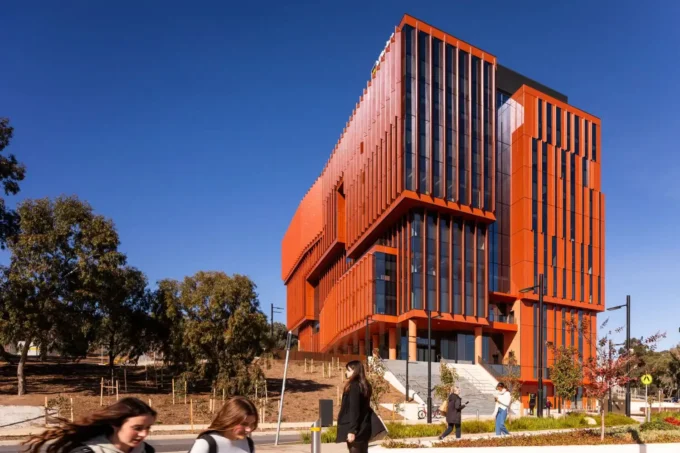The Boerhaavecomplex, a post-war housing ensemble located in Leiden, Netherlands, has undergone a thoughtful transformation led by Geurst & Schulze Architecten. Originally designed by Ernest Groosman as a visionary residential prototype for hospital staff, the complex once reflected the social optimism and urban experimentation of its era. Over time, however, its infrastructure became outdated, and its communal nature faded.
In response, the architects reimagined the site not as a tabula rasa but as a foundation on which to build a renewed, vibrant urban living environment. The resulting intervention delivers a high-quality, contemporary housing complex that balances historic continuity with modern functionality, while significantly improving its integration with the broader neighborhood.

From Prototype to Contemporary Community
Post-War Ambitions and Present-Day Realities
When it was constructed, the Boerhaavecomplex represented a bold approach to post-war urban housing. Designed as part of a larger plan that was never fully realized, it included four substantial apartment blocks arranged in a rectangle. These blocks were accompanied by a network of communal spaces—a feature that encouraged interaction among residents and supported the hospital community it was built to serve.
Over the decades, much of that original vision faded. Communal amenities were lost, apartments no longer met modern expectations, and the site became increasingly disconnected from its urban surroundings. Technical evaluations further revealed that certain structural elements—particularly one of the blocks—were too lightly constructed to be preserved safely, making full-scale renovation impractical.
A Respectful and Strategic Rebuild
Retaining the Spirit, Upgrading the Structure
Rather than erasing the site’s history, Geurst & Schulze Architecten adopted a layered design strategy. They preserved the original footprint and spatial layout, reinforcing the open nature of the plan, while integrating higher-density housing suitable for a younger, international demographic—a group that frequently faces challenges in the Dutch housing market.
The complex has been rebuilt in four phases, ensuring that residents could relocate within the project during construction. This phased approach allowed for community continuity and minimized displacement. Each phase reflects a strong architectural consistency while responding to evolving needs.

Strengthening Urban Integration
Transparency, Accessibility, and Shared Green Space
A key goal of the new design was to reconnect the complex to the surrounding urban fabric. This was achieved through several interventions:
-
Transparent entrance halls now face outward, improving visibility and encouraging interaction between residents and passersby.
-
Bicycle storage areas offer views into the interior garden, enhancing both security and permeability.
-
The car park has been transformed into a public square, further breaking down barriers between the housing block and the city.
At the heart of the project is the inner courtyard, which has been activated with a playground, garden areas, and open pathways. This space encourages community engagement and ensures that all units—whether large or small—have a direct connection to nature and one another.
Cohesion Through Craft and Material
Brickwork as Architectural Language
Material choices play a central role in tying the complex together, both internally and with the broader neighborhood. The architects selected brick as the primary exterior material, not only for its durability but also for its tactile and expressive qualities. Relief brickwork articulates each façade into a clear base, middle, and top, providing a visual rhythm and human scale.
Different apartment types are stacked logically above ground-floor units with direct street access. Some of the top-floor apartments feature full-width balconies, while others have French balconies, offering a variety of outdoor experiences across dwelling types.
This attention to detail and hierarchy in the façades creates a refined but approachable architectural identity. The use of brick, both in pattern and tone, ensures cohesion between the new construction and the post-war legacy of the site.

A Model for Urban Renewal
The Boerhaavecomplex redevelopment is not just a physical intervention—it is a social and urban one. It revives the communal values on which the original complex was built, while adapting those values to contemporary lifestyles and needs.
By enhancing density without compromising quality, reinforcing historical structures where possible, and inviting community participation through design, Geurst & Schulze Architecten have set a new standard for context-sensitive urban renewal.
Completed in 2024, the project stands as a testament to how thoughtful architectural design can breathe new life into aging urban fabric, creating inclusive, sustainable, and beautiful places to live.
Photography: Stefan Müller
- Adaptive Reuse in Urban Planning
- Architecture for Urban Integration
- Bicycle-Friendly Housing Design
- Boerhaavecomplex Leiden
- Brick Architecture Leiden
- Communal Courtyard Housing
- Contemporary Dutch Brickwork
- Context-Sensitive Urban Design
- Dutch Residential Architecture
- Geurst & Schulze Architecten
- Human-Scale Urban Housing
- Inclusive Neighborhood Architecture
- Inner Courtyard Living Design
- Material-Driven Architecture Netherlands
- Phased Housing Renovation
- Post-War Housing Renewal
- Post-War Residential Complex Redesign
- Social Housing Redevelopment
- Sustainable Housing Redevelopment
- Urban Regeneration Netherlands














































Leave a comment